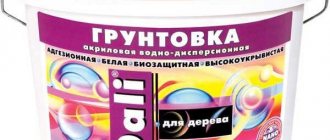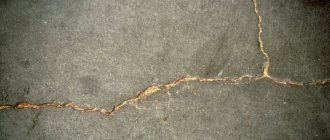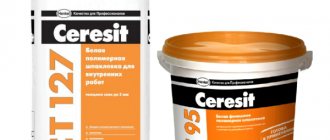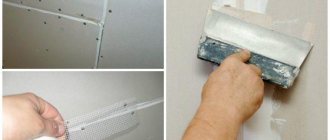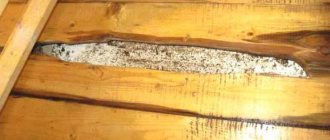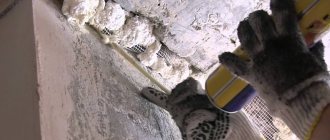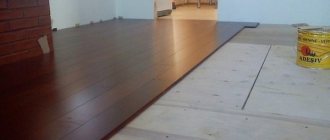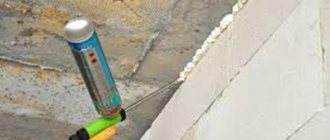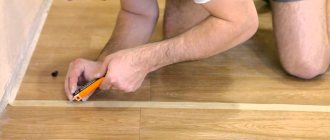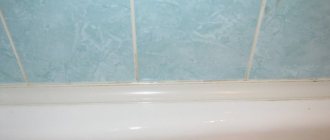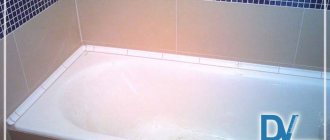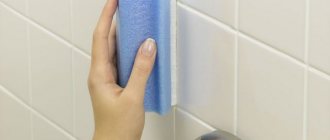Floor coverings experience very high loads. In addition to the fact that they must be durable, they are subject to increased requirements for wear resistance, resistance to moisture and aggressive environments.
Equally important are the evenness of the surface and aesthetic appearance. All this can be achieved by concrete floor putty.
Concrete floors are most often found in industrial buildings: factory floors, warehouses and retail premises, garages, etc. Here they are subjected to serious mechanical stress, chemical and physical influences, and therefore must have a number of special properties.
In residential premises, such floors are the basis for decorative coverings:
- Linoleum;
- Laminate;
- Parquet and parquet boards;
- Ceramic tiles (see);
- Paints;
- Self-leveling polyurethane floors;
- Porcelain tiles (see).
These materials are laid only on a flat and smooth surface that is resistant to moisture and mechanical damage. It should not crack or crumble, releasing harmful dust into the air.
Putty for a concrete floor or cement screed can improve the quality characteristics of the base, but for this it itself must have certain properties, which include:
- Waterproof;
- Moisture resistance;
- Mechanical strength;
- Wear resistance;
- Durability;
- Environmentally friendly, safe to use.
In addition, the putty must adhere well to the base and have high adhesive properties. What materials meet these requirements?
Features of working with linoleum
This type of finishing coating is demanding on the quality of the rough base. The floor must be smooth, without humps, depressions, cracks, or sinkholes. If you lay linoleum on an unprepared base, it will soon begin to wear out and tear in places where there are obvious bulges - its service life will noticeably decrease. To avoid this, putty the floor, and then lay a special layer under the finishing coat.
Sealing of unevenness is possible only on a foundation of fairly decent quality, with a small difference in level and a small number of errors. If there are bumps and holes at every step, you will have to first pour a self-leveling concrete screed and only then start laying linoleum.
How to level a floor under linoleum: detailed instructions on how to do it
To lay linoleum, you need a flat base, otherwise the coating will not last long, and its appearance will be poor. For wooden and concrete floors there are several leveling methods, each of which has its own differences; the article will provide detailed instructions.
This article talks about why leveling is needed, how best to fix a wooden floor, how to smooth a concrete surface, and what tools and materials are needed for this.
Types of putties
You need to select the material based on the type of rough foundation. This is usually concrete, or wood, or concrete leveled with sheets of plywood. The joints between them will also have to be puttied. In addition to specific compositions intended for a particular type of floor, there are also universal ones that can be used to work on both wood and concrete.
Wood putty
Features of the composition for work inside residential premises:
Oil-based formulations
Oil putties include drying oil, fillers, water, coloring pigments, plasticizers and other components. Such compositions are considered ideal for wood, as they have natural ingredients. The advantages of oil putties include:
Unlike most other putty mixtures, leveling oil compositions go on sale ready-made. They do not require pre-mixing before application to the surface to be treated.
Despite the many advantages, the material also has quite serious disadvantages. Putty can quickly “fall out” of cracks and potholes if the floor is subject to intense stress. Oil-based compositions are sensitive to excess moisture and do not adhere well to any paint other than oil-based paint. Therefore, before working on plywood or wood floors, you will have to strip them of any finish down to the wood itself.
Quick-drying compounds
Nitro putties are made from wood dust (flour), have a wide variety of colors, and dry very quickly. Among the advantages:
Polymer compositions
They are made on the basis of gypsum or latex. Gypsum putty for plywood under linoleum is quite suitable for sealing joints between sheets, as well as for bringing wooden floors into ideal condition, on which a similar finishing coating will then be laid.
Latex putties are an excellent, high-quality option. You just need to know how to work with them. After setting, it is almost impossible to do anything with the surface. Therefore, you need to immediately seal cracks and potholes perfectly evenly, without leaving any errors.
The advantages of latex over gypsum are obvious:
Among the disadvantages, we can note the price - it is hardly worth using latex putty under linoleum (although if the result is important, then it will be better) - and the inability to work at low temperatures.
Adhesive and oil-adhesive compositions
Usually they are prepared independently. It turns out to be economical and quite high quality. Recipe for wood putty (it is also suitable for sealing plywood joints):
Combine turpentine and linseed oil, add perlite powder. Mix everything, pour in water, add the remaining ingredients and place in a water bath, heat to approximately +90° C. This will help achieve the most uniform consistency and obtain a thick paste. Remove it from the heat and cool. You can work with it for an hour, then its properties will deteriorate.
The recipe for pure adhesive putty is simpler:
The quality of this putty is quite high, the price is more than affordable. The downside is that it takes a long time to dry, at least a day, and the thickness of the layer plays a big role.
In the last recipe, you can replace PVA glue with water-soluble inexpensive varnish. Leave the mixture overnight to allow the sawdust or wood flour to swell. The resulting putty dries faster and is therefore more attractive to use.
Putties for concrete
There are 7 types of compositions: cement or gypsum based, lime, oil, varnish, adhesive, acrylic. Unlike wood, it is easier to work with concrete; the main thing is not to forget, after thorough cleaning, to impregnate it with a deep-penetrating primer with the addition of sand. This will improve the adhesion of the putty to the base and prevent it from flying out during the application of mechanical loads.
Gypsum has clear advantages - it does not shrink and is inexpensive. Cement gives a decent shrinkage, but can be used in rooms of any humidity, unlike gypsum, which does not like water. Acrylic putty does not shrink, is moisture resistant, but is more expensive than gypsum.
The most attractive is epoxy putty for concrete. It practically does not peel off from the base, is waterproof, strengthens the edges of potholes, and fills even small cracks well.
What is the best way to fix wood flooring?
Wooden bases are a common occurrence in Soviet apartments, country houses, and cottages.
Over time, the wooden flooring becomes deformed, cracks and gaps appear, and therefore it must be leveled before laying linoleum. Alignment methods:
- Cycling.
- Coating with putty.
- Installation of plywood panels.
- Use of dry self-leveling mixtures.
Let's talk about each of them in more detail.
Cycling
For sanding, it is best to use a sanding machine, but if you don’t have one, a regular plane will do. Processing begins from the far wall towards the doors.
Rules for using the scraping machine:
- make sure that there are no metal objects on the floor or nails sticking out;
- use special headphones when working;
- use a respirator to prevent dust from entering your respiratory tract;
- The device is noisy, so carry out work within the permitted time.
Processing by scraping takes place in 2 stages.
- After the first cleaning, the surface must be covered with putty, eliminating all defects. When it dries, you can begin secondary processing.
- Once leveling is complete, vacuum the room, treat the base with an antiseptic, and then coat it with a protective varnish. Then you can start laying linoleum.
Putty
The method of leveling with putty depends on the type of material chosen:
- For wooden surfaces, a composition of sawdust with glue is suitable, which will cope even with minor defects. Such mixtures are good protection against moisture, noise, and unwanted insects.
- Dry putty mixtures, which are diluted to a creamy consistency and applied to the sanded surface.
- Simple dry putty is the most economical, but labor-intensive way to cover a wooden floor.
Plywood
This method is suitable for situations where you need to level a floor installed at an angle.
Plywood panels laid in two layers make it possible to bring the floor level to a horizontal level. Sanded sheets with a thickness of 10 mm will be optimal. The work order is as follows:
- Plywood sheets are divided into squares measuring 60x60 cm. In this case, the material must be smooth, without chips or cracks.
- Then self-tapping screws are screwed in at a distance of 20–30 cm from each other, which will serve as beacons.
- Logs are installed on the floor - support beams made of plywood. The width of the logs should be 3–4 cm. Self-tapping screws or wood glue are used for fastening, and the space between the beams is filled with insulation.
- Plywood panels are mounted on the prepared logs with self-tapping screws, and the gaps between the sheets are puttied. When laying, plywood must be treated with an antiseptic.
- The final coating is sanded and coated with a protective varnish.
In order for a plywood floor to last a long time, it is recommended to use a special underlay, on which linoleum is subsequently laid.
Self-leveling mixtures
Dry flooring mixtures allow you to achieve a perfectly smooth surface. Instructions for diluting the mixture are indicated on the packaging, and anyone can master the filling technology:
- The base is cleaned of dust and dirt. Cover with a primer to make the coating more airtight.
- A reinforcing mesh is installed to give the surface strength.
- The prepared mixture is poured into wide strips (about 30–40 cm) and spread with a wide spatula. Then you need to go over the mixture with a needle roller so that there are no bubbles.
- A layer of sealant is applied along the walls. All work must be done quickly, since the “lifetime” of the self-leveling mixture is short.
- When the first layer has dried, proceed to the finishing coat.
Preparing plywood for puttying
If everything is clear with the preparation of a concrete surface: clean, fill out all the cracks and holes, then remove dust, prime, dry and you can start puttingtying, then with a wooden floor, and even more so with plywood, everything is much more complicated.
The first thing to do is to saturate the floor with drying oil. It needs to be heated to +50 - 60° C and applied with a brush (roller). Force dry the treated surface using a hair dryer at +200° C. The treatment must be done multiple times, drying the layer well each time. After 3 or 4 soaks, drop water onto the surface of the plywood. If it collects in drops, the treatment can be completed, but if it is absorbed, you need to dry it a few more times. Don't forget about the edges, otherwise when moisture penetrates they will ruffle and then separate.
A similar water-repellent effect can be obtained by impregnating plywood with PVA glue.
Before laying linoleum, be sure to fill all uneven areas. And it doesn’t matter what kind of floor you have - wood or concrete. The main thing is to make it almost perfectly flat, then lay a backing and lay linoleum on top.
Source
Video description
Seal gaps between floorboards using wood sealant.
We have discussed in detail what means can be used to seal cracks in a wooden floor so that after restoration the paint lays evenly and former defects remain invisible. How long the repaired flooring area will last depends on the correct use of the material.
Putty for concrete floors: features of selection and work
Putty for concrete floors is a special building material that is supplied in the form of a dry or liquid mixture that requires preparation, intended for finishing surfaces in order to implement various tasks. Most often, concrete floors are covered with putties to give them the necessary characteristics of rigidity and strength, extend their service life, level them, and prepare them for finishing.
A concrete floor experiences high mechanical loads and must be as reliable, wear-resistant, and able to withstand aggressive influences. Due to the peculiarities of the porous structure of a concrete monolith, untreated concrete can become dusty and deteriorate over time, subject to the spread of a network of cracks and the appearance of other deformations (chips, potholes, etc.).
Even if you plan to finish the concrete with a floor covering, pre-treatment of the surface will extend the service life of the finishing layer and eliminate a lot of problems. One way or another, concrete reinforced with putty demonstrates increased characteristics of durability, comfort, and strength. In addition, putties are used to level concrete in the presence of small differences.
Application of putty
Most often, concrete floors without finishing material can be found in industrial buildings - factory workshops, garages, retail and warehouse premises, etc. Here the most important requirement for concrete is strength to mechanical loads and wear; in addition, floors are provided with resistance to physical and chemical influences, temperatures, moisture, etc.
For which coatings is treatment with putty for a concrete floor relevant: under parquet and parquet boards, laminate and linoleum, ceramic tiles and painting, porcelain tiles and self-leveling polyurethane floors. These materials require a perfectly smooth and even surface, resistant to mechanical damage and moisture, capable of not crumbling, cracking, or dusting.
Properties
Putty is selected in accordance with the functions it must perform. So, for example, for floors in industrial premises it may be important to ensure maximum wear resistance and strength, for certain residential premises - to minimize exposure to moisture and temperature changes.
Putties are selected according to the type of finishing coating, the purpose of the room, the functions of the floor and other factors. The modern market offers a fairly large selection of various compositions, most of which meet basic requirements, while for specific ones it is important to select specific substances.
Types of putties for concrete floors
Any putty is a mixture of binding components with water, with the possible introduction of fillers (crushed stone, sand) and additives to increase plasticity. The binders usually include cement, glue, epoxy resins, polyester, and polyurethane. The market offers a large selection of putties in different formats - ready-to-use mixtures, one/two/three-component dry compositions (requiring mixing with water before use).
Due to the high cost of putty compositions for concrete, they are often made by hand - from drying oil, sand, cement, acrylic varnish, PVA glue, etc. But it is impossible to guarantee quality and compliance with the required characteristics when using such products.
When choosing the type of mixture, they take into account the properties and type of base, the purpose of the room, the technical parameters of the solution, and the assigned tasks. Thus, the coating may require the elimination of many defects or require a high level of vapor permeability, strength, etc. If you plan to lay a finishing finish on top of a concrete floor, be sure to take its properties and features into account.
Plaster
Gypsum-based mixtures are considered the most common and relatively affordable.
Cement
Such mixtures are usually prepared with your own hands and used to level the concrete floor under typesetting or sheet floor coverings.
Special
Special-purpose mixtures in the composition may include special components designed to lower or increase certain indicators, improve certain properties intended for floors in a certain condition, coatings of various types.
Often such putties demonstrate increased values of frost resistance and water resistance, are not afraid of very heavy loads, sudden temperature changes and, in general, demonstrate more serious characteristics that are important for production and premises for certain purposes.
Acrylic
Ready-made paste putty created on the basis of reinforcing fibers and acrylic copolymer. The main task of such a composition is to repair deformed foundations, seal cracks, seams, and joints.
The material has practically no disadvantages.
Epoxy
This type of putty is used when it is necessary to level and strengthen a concrete floor with noticeable damage in the form of embroidered seams, large cracks, and traces of removed reinforcement. The epoxy composition tightens the concrete surface well, increases service life and strength.
Waterproofing putty for further sanding of floors
Waterproofing putty demonstrates increased moisture resistance due to its urethane components, dispersion emulsion, targeted additives, and dry base. The substance can be used as an independent coating.
It is often used for the restoration of old concrete surfaces where humidity is high (steam room, bathroom, shower). The main advantage of the composition is that it is not necessary to wait for it to dry completely; you can continue to work on the wet layer.
Puttying under linoleum
This type of work is carried out in compliance with certain rules, since the floor under the linoleum must be dust-free, perfectly smooth, without any defects, capable of withstanding considerable loads (transmitted from the linoleum) and point impacts.
Plywood sheets are an excellent material for creating smooth floors
If the wooden floor in your home has noticeable unevenness or slope, the considered methods for leveling it will be ineffective. In such situations, it is better to use 10-mm thick sheets of plywood marked FK (for residential rooms) and FSF (for non-residential ones). For DIY work, polished products are more suitable (they do not need additional processing). But you can also use plywood without sanding. You will also need universal self-tapping screws or screws, a jigsaw, a building level, and a screwdriver.
Technology for leveling the floor with putty during do-it-yourself repairs
Before starting puttying, the concrete surface is thoroughly cleaned of debris and dust - for this you can use a construction vacuum cleaner or an ordinary broom. Next, priming is carried out to ensure better adhesion of the materials.
The putty is simply poured onto the floor, and then carefully leveled with a spatula or a special brush over the surface. This makes it possible to obtain a thin coating that is as evenly and evenly distributed as possible over the floor. After the work is completed, the room should be wet cleaned and everything should be thoroughly cleaned.
The modern market offers a fairly large selection of various putties for concrete floors that meet various requirements, guarantee the required characteristics and must be used strictly according to the instructions.
Source
What is putty used for?
The concrete floor itself has high strength, but if there are minor defects (chips, cracks and crevices) and poorly puttied slab joints, it can be subject to destruction, which will entail repairs and significant financial costs, especially when it comes to public buildings.
Additional strengthening of the concrete base will also be required in cases where cheap materials were used in construction. Treated floors have a number of advantages:
Putty mixtures thoroughly and reliably level the floor, ensuring easier further installation of building and decorative materials.
What you need to know
Wood floor putty has some characteristics that should be taken into account when finishing work. It is important to consider the following nuances:
- Putty loses elasticity when exposed to negative temperatures. In this regard, it is better not to repair wooden surfaces outdoors in winter;
- The permissible level of width and depth of cracks for sealing must be within 10 mm. Otherwise, it is better to perform preliminary caulking;
- If the wood moisture content is more than 12%, the visit must be thoroughly dried.
Putty mixtures for concrete
Putty materials can be basic and finishing. But there are also intermediate universal options suitable for all operations; they are much more economical and have low consumption.
Putty for concrete floors
Based on their component composition, mixtures of the following types are distinguished:
Basic putty PROMOTERS 5 kg
Often, manufacturers additionally enrich the putty with polyester or polyurethane additives. Such materials have minimal shrinkage and high waterproofing properties.
According to the form of release, the mixtures are:
Alpina Feinspachtel finishing putty for treating walls and ceilings made of gypsum boards and concrete
Depending on the application method, the putty can have a liquid or thick consistency. The first type is typical for self-leveling compounds used for treating concrete floors. Such mixtures, under their own weight, are effortlessly distributed evenly over the entire surface, characterizing the continuous puttying technique.
Gypsum mixtures
Eco Finish gypsum finishing putty
Gypsum-based putty mixtures are the least popular option for leveling the surface of concrete floors. The advantages of this material include:
The gypsum composition creates a perfectly smooth surface from the first layer, dries quickly and can be colored with any color (as a more budget-friendly option, you can use artistic gouache), however, it has one significant drawback - the material is not suitable for rooms with high humidity.
Price for gypsum putty
Primary requirements
Regardless of the type of putty materials, they all must have the following qualities:
- uniformity of texture;
- good adhesion;
- quick drying;
- absence of impurities and inclusions in the composition;
- Excellent wood coating followed by light sanding.
Before starting any work, even after studying the composition parameters indicated on the packaging, it is better to first test the mixture on a piece of solid wood.
Cement putties
Prospectors basic cement putty (20 kg)
Cement-based putty mixtures successfully combine reasonable prices, consistently high quality coatings and moisture-resistant properties. But the material also has a number of disadvantages, including:
Special component mixtures make the finished coating resistant to temperature changes and allow the use of such putties in rooms with extremely low and high humidity, since strength and durability are maintained throughout the entire service life.
Price for cement putty
Plaster breathes best of all materials
The disadvantage of gypsum mixtures is hygroscopicity and low strength. They perform well in dry rooms, absorbing excess moisture and releasing it when the air becomes dry. The surface of the gypsum putty is smooth. Otherwise, it can be sanded with a machine. The underfloor heating system maintains a constant temperature, and the plaster feels great. Heating does not affect its quality.
The floor covering protects the putty from abrasion and impact. The plaster sets in 15 - 20 minutes, and then dries for about a day. You need to apply it quickly and give it time to settle. The screed will be smooth and without cracks.
Acrylic mixtures
One of the most convenient forms - it hardens quickly and creates a smooth surface. The multi-component system is not subject to shrinkage and is not afraid of water.
In addition to water, the composition of polymer putty for concrete floors includes sand, marble chips, cement, and synthetic additives. This putty is plastic, has good waterproofing properties and adhesion to the surface being treated, is waterproof, and elastic, which makes it an excellent material for preparing surfaces for self-leveling and heated floors. But its use is advisable on surfaces with a small number of deep cracks and gouges.
Price for polymer putty
Video description
Securely level old floorboards
Construction foam
This material is most often used to seal joints between the wall and wooden boards on the floor. This option is also suitable for sealing large cracks and damage in the floor. Before using such a product, the surfaces of the gaps are moistened with water so that the liquid foam adheres better to the wood.
It is recommended to apply polyurethane foam in small quantities, as it tends to expand and subsequently the boards may begin to deform, which will negatively affect the plane of the floor.
Acrylic sealant
Sold in special tubes equipped with a syringe. Ideal for filling gaps between laminate and parquet joints, and eliminating spaces between dry boards.
After applying the composition, the boards will stop moving, the creaking will disappear, and it will be comfortable to move on the floor. The acrylic sealant on top can be painted with enamel or special paint for wooden floors.
Acrylic sealant for sealing cracks in wooden floors Source materik-m.ru
Epoxy mixtures for concrete floors
Epoxy putty 250 g
If it is necessary to level and strengthen a concrete base with a damaged structure (large cracks, embroidered seams and traces of reinforcement removal), the most effective would be the use of epoxy putty mixtures, which tighten the concrete and increase its strength and durability.
Price for epoxy putty
The advantages of such two-component systems, consisting of a base and a hardener, are:
Epoxy mixture is a finishing material ideal for smoothing out all the depressions and unevenness of the floor covering.
Epoxy resin putty
Use of polymer putties
Concrete putty is intended for waterproofing and leveling the cement or concrete base of the floor before applying the main coating to it. The diluted putty mixture, when spread, fills cracks, cavities, potholes and small irregularities in concrete, forming an even and durable film after hardening and drying.
Polyester leveling putties must be applied in thin layers, no more than 2 mm thick. Each subsequent layer is applied after the previous one has dried; as a rule, it is enough to apply 2 layers of putty.
Waterproofing putty mixture
A special feature of the mixture with increased moisture-resistant properties is the possibility of using it as an independent coating, which will be beneficial with a limited budget for repair work. The composition of the putty includes urethane components, a dry base mixture, a hardener, targeted additives and dispersion emulsions.
Penetrating waterproofing compound Ceresit CR 90 Crystaliser (25 kg bag), bag
Most often, waterproofing putty is used when carrying out renovation work in bathrooms, steam rooms and showers.
The main advantage of the material is that there is no need to wait for the base to completely dry and the ability to work on a wet layer.
Price for waterproofing putty
Criteria for choosing putty
How to choose putty
It is very important to choose the right building mixture, taking into account the properties of the surface being treated and the purpose of the room. It is important to pay attention to the following properties of the putty mixture:
Important! Pastes and mixtures for concrete bases are not suitable for aerated concrete and vice versa. Because they contain various component additives suitable for a specific structure. When choosing a mixture, you need to remember that how evenly and smoothly the finishing materials (parquet, laminate, linoleum or ceramic tile) will lie will depend on its quality.
Step 1. Preparing the work surface
The room in which the work will be carried out must be prepared in advance. It is advisable to remove the old floor covering, widen deep cracks and crevices using a drill and clean with a construction vacuum cleaner.
Cracks should be widened and cleaned
It is very important to remove all stains from the floor:
Usually they are easily washed off with warm soapy water, but if necessary, you can use specialized products.
Step 2. Prime the surface
Before priming, the floor should be cleared of debris or swept again. The primer must be selected based on the characteristics of the room, its humidity and purpose.
To apply the composition you will need the following materials:
The primer is applied in two layers, each of which is thoroughly dried. A high-quality composition will seal pores and small cracks, making the next step easier.
Important! If the base is smooth, then it is preferable to use a primer with a quartz filler - it will ensure stronger adhesion of the putty to the concrete due to the rough surface obtained after priming.
Step 3. Preparing the solution
Mixing the mixture for floor repair
The putty can be purchased ready-made, or you can mix the composition yourself. To do this, you will need a drill with an attachment or a construction mixer, a suitable container and dry mixtures. It is very important to follow the dilution proportions indicated on the packaging.
There is no fundamental difference between the coating obtained from thick and liquid plaster, but there is a difference in applying the composition to the working surface.
Experts advise adding 10-15% more water than the manufacturer recommends. The optimal ratio of dry mixture and water is 1:5, the minimum is 1:3.
Sometimes you can add sifted chalk, crushed sawdust, and PVA glue to the building mixture yourself.
The sawdust must first be soaked for 12-14 hours, and the entire mixture must be stirred twice with a mixer. To putty bathrooms, drying oil is added to the composition - this will make the final coating even more resistant to temperature changes.
Keep in mind that the solution thickens after 3-4 hours and becomes unusable, losing up to 20-25% of its properties, so you should not make a lot of construction mixture at once.
Step 4. Applying material to the surface
Repairing a large crack
The puttying process is quite long and painstaking. The tools you will need are the following:
For convenience, you can purchase a rubber spatula or a tool with comfortable handles, be sure to take care of personal protective equipment and gloves. The putty is applied in 2-3 layers, each no more than 4-5 mm thick. You should not try to eliminate all unevenness with putty - this process is carried out during the execution of the floor screed.
The putty will dry completely after 24 hours. If there were deep cracks, the process may take 2-3 days. It is important to dry without drafts or sudden temperature changes.
Useful tips
In order to properly putty a plywood floor in a room, it is important to choose the right finishing mixture and skillfully apply it to the base. To obtain the desired result, you must follow the recommendations of experienced specialists:
- Puttying must not be carried out at excessively low temperatures. It is best to plan this procedure for the summer.
- Before sealing the main part of the surface, you should carefully treat all potholes, cracks, and other floor defects.
- Only holes whose depth does not exceed 1 cm must be sealed.
- Putty is applied to the wood floor only after it has been thoroughly dried.
- When purchasing a ready-made mixture, you should check the contents of the product by opening the lid of the container. The presence of multiple solid particles in the mass indicates poor quality of the product.
- Before using any finishing agent (putty, primer, sealants), it is strongly recommended to study the instructions for its use. It is unacceptable to ignore the manufacturer's instructions and warnings.
- The putty composition must be diluted in small portions: the finished mixture dries quickly, as a result of which it loses its positive properties and, accordingly, becomes unsuitable for use.
- Even before starting the puttying process, it is advisable to apply PVA glue, previously diluted in a small amount of liquid, to the plywood surface.
- The putty applied to concrete must be more liquid than that used for finishing wall surfaces and ceilings.
- If there are a huge number of cracks on the surface, finely dispersed compounds are used. But at the same time, the depth of the cracks is filled with coarse material.
- After all problem areas of the flooring have been puttied, you need to thoroughly clean the base with sandpaper.
Before puttingtying a plywood floor, it is advisable to apply PVA glue to its surface, diluted in advance in a small amount of water. Source stroy-podskazka.ru
If the financial budget for repair work is limited, then the putty can be made independently. To do this, you must use one of the following proven recipes:
- Combine PVA glue with crushed chalk. In this case, a fairly thick mass of viscous consistency should form. If large uneven areas or deep cracks are to be treated, then it is advisable to add a little sawdust to the composition.
- For use in rooms with high humidity levels, you can prepare an oil solution. Its production requires the following ingredients: drying oil - 1 kg, chalk - 2 kg, drying accelerating substance - 100 g.
- Mix acrylic varnish with pre-crushed chalk. After prolonged mixing, the mixture should form a paste.
- At home, it is easy to prepare putty, which in its characteristics is similar to an acrylic mixture. For this you will need: rosin - 200 g, ozokerite and yellow ocher - 0.4 kg each. All ingredients are placed in a metal container, then the contents are heated over a fire to dissolve it. The finished putty composition is applied only when hot.
- The most economical way to make a leveling mass for concrete with your own hands is to combine gypsum and chalk (proportion – 1:2). Additionally, PVA glue should be added to the composition. Another option is to mix varnish with cement. The latter product guarantees the highest quality result, since the surface treated with it is characterized by increased strength.
When mixing any ingredients, it is important to strictly adhere to safety precautions: improper use of chemicals can harm human health. To do this, it is recommended to use protective equipment (rubber gloves, a respirator). In addition, it is advisable to prepare all solutions outside or in well-ventilated areas.
Mixing various chemicals included in putty at home should be done with extreme caution. Source stroy-podskazka.ru
